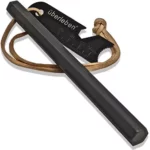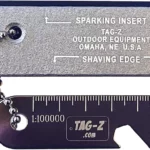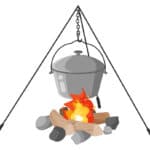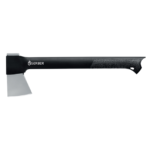Water harvesting techniques for sustainable prepping focus on collecting and using rainwater. This method is simple and uses everyday items like tarps and gutters to catch water efficiently.
It’s a smart way to gather water without spending too much, with things like barrels and buckets perfect for storing it. Keeping water fresh in 5-gallon jugs and changing it every six months ensures you always have safe water in emergencies.
Tools like the First Flush Diverter improve the quality of rainwater by removing early contaminants. To make this collected rainwater safe to drink, boiling or adding purification tablets or bleach is necessary.
Keeping your water tanks warm stops them from freezing, making sure you have usable water no matter the weather. Rainwater harvesting is great for our planet because it uses less fresh water from natural sources and helps cut down on pollution.
Plus, rainwater can be better than well or spring water for both people and plants—and very useful during big disasters where usual supplies might not work.
Let’s explore how these techniques can help us start prepping better.
Table of Contents
Understanding Rainwater Harvesting
Rainwater harvesting is grabbing water from the sky for future use. It’s a smart move, especially when you think about how sudden disasters can break pipes and cut off water supply.
This method uses simple tools like gutters, barrels, and filters to catch rain. Then, it stores this treasure for times of need—like when taps run dry or gardens thirst for a drink.
Systems can be put together without spending much money or time. Think of using stuff you might already have at home. Once set up, these systems give us control over our own water supply, making us ready for any emergency.
Next up, let’s explore some techniques for catching those precious drops!
Techniques for Rainwater Harvesting
Gathering rainwater can be simple or complex, depending on the method. From barrels to sophisticated systems, each has its own way of catching and storing rain for future use.
Using Barrels and Buckets
Using barrels and buckets for rainwater harvesting is smart and budget-friendly. You just catch rain as it falls from your roof. Place barrels or buckets under downspouts and let gravity do the work.
This way, you collect water without spending much money.
Make sure they are easy to get to because you’ll use this water for plants, cleaning, or flushing toilets. Checking local rules about collecting rainwater is a good idea, too. Some places have special guidelines.
Implementing a Dry System
A dry system for rainwater harvesting uses gutters and downspouts to move water from your roof directly into a storage tank. This setup is simple, making it easy to collect and store rainwater without it touching the ground.
You can set up this type of system with basic materials found around the house. It’s a cost-effective way to manage stormwater and reduce water bills.
To keep the collected water clean, it’s essential to filter out leaves and debris before they enter the storage tank. A mesh screen or gutter guard can do this job well. For safe drinking, boiling harvested water is crucial, especially if it has been in contact with surfaces like roofs or tarps.
This method helps ensure your stored rainwater remains safe for use in household tasks or even as an emergency water source during dry spells.
Designing a Wet System
Designing a wet system for rainwater harvesting involves pipes that carry water straight from the roof to storage tanks. These systems often use larger pipes than dry systems, making sure water moves quickly and reduces chances of blockages.
The setup includes gutters, downspouts, and sometimes even underground pipes that lead directly to cisterns or barrels for storing rainwater. This method works well in areas where it rains a lot because it can handle large amounts of water fast.
With this type of system, you can collect a lot of water without much effort. It’s key to have filters at the entrance points to keep leaves and debris out. Also, plan for overflow routes so extra water doesn’t damage your house’s foundation.
Wet systems are great for using with irrigation or bigger storage needs since they’re efficient at moving and collecting a lot of water quickly.
Components of Rainwater Harvesting Systems
Every rainwater harvesting system needs a few key parts—like a way to catch water, move it, clean it first, keep it stored, make sure it’s safe to use, and then get it where you need.
Keen to learn how these components work together? Keep reading!
Collection Surface
The collection surface is key in rainwater harvesting. This is where water first lands and gets collected. Roofs work well for this purpose. The materials used should be free of toxins to keep the water clean.
Tarps, gutters, and downspouts can help gather rainwater effectively.
Choosing the right surface helps avoid contaminating the water with pollutants. It’s crucial to ensure that stored rainwater remains safe for use in gardens, toilet flushing, or even potable uses after proper treatment.
Safe collection surfaces play a big role in sustainable living by providing an eco-friendly source of water.
Conveyance System
Gutters and downspouts grab rain from your roof. They play a big part in moving water to the right place. This setup is key for getting rainwater where you want it, without mess or waste.
Tarps can also catch rainwater. They help keep your water clean by stopping dirt and bugs from getting in. Make sure all containers are covered well to fight off debris and insects.
This keeps your stored water safe to use later on.
First Flush Diverter
A First Flush Diverter is key for cleaning rainwater before it goes into storage. It catches the first bit of rain, which has most of the dirt and leaves from roofs. This dirty water gets pushed aside so only clean water fills your tank.
Think of it as a gatekeeper that stops bad stuff from getting into your stored rainwater.
This device makes sure your harvested rainwater is better for use around your home or garden. Removing debris and pollutants early saves you time and effort in keeping water clean later on.
Plus, by improving water quality, it helps with tasks like watering plants or flushing toilets with less worry about what’s in the water.
Storage Tanks
Storage tanks hold the rainwater you collect. These can be big barrels or even larger containers. It’s key to pick ones that fit your space and needs. For places with cold winters, make sure to wrap these tanks in blankets, Styrofoam, or fiberglass.
This keeps the water from freezing. Also, remember to clean and refill 5-gallon jugs every six months. This ensures your water stays fresh for when you really need it.
These tanks are part of a bigger system that collects and cleans rainwater for you to use. By storing rain for non-potable uses like watering plants or flushing toilets, they help save precious drinking water and cut down on energy use.
Picking the right tank is vital for making your harvesting system work well and last long.
Filtration and Purification
Filtration and purification turn collected rainwater into safe drinking water. First, remove big pieces like leaves or dirt with a filter. Then, kill germs in the water to make it drinkable.
You can use Halazone tablets, bleach, iodine, or boil the water for this step.
Rainwater from the sky is usually clean but touching roofs or tarps adds stuff you don’t want to drink. Always purify water before using it to be safe. Roofing materials should not have toxins that could mix with your water.
This keeps your harvested rainwater healthy and ready for use anytime.
Distribution
After filtering and purifying, the next step is getting the water where it needs to go. This is called distribution. Pipes or hoses take cleaned rainwater from storage tanks to your garden, toilet, or washing machine.
Some systems use gravity for this job — if your tank is high up, water flows down without needing a pump. For areas that need it, small pumps push water through pipes to reach higher places.
Planning how to move water around is key for efficiency and saving energy. Shorter paths mean less work for pumps and lower costs for you. Keeping distribution simple makes managing stormwater easier and helps in conserving water every day.
Benefits of Rainwater Harvesting
Rainwater harvesting helps the planet and your wallet. It cuts down on water bills and protects our future water supply.
Environmental Conservation
Harvesting rainwater helps fight climate change and lessens the demand for freshwater sources. This practice saves valuable water from being wasted. Using collected rain reduces carbon footprints, making a big difference in protecting our planet.
It turns rooftops and gutters into tools against urban flooding, soil erosion, and water scarcity.
This method also recharges groundwater, supporting rivers, creeks, and streams. By managing storm runoff smartly, it protects local environments from pollution and damage. Rainwater collection proves that every drop counts in conserving water for a healthier world.
Water Security
Water security is a big deal because everyone needs clean water to live. Rainwater harvesting plays a key role here. It helps by catching and storing rain, which can be used for drinking, cooking, and growing food.
This method cuts down on the need for water from other places like rivers or city systems, making more water available for everyone.
Using rain barrels or designing more complex systems to collect rainwater reduces pressure on public water supplies. Plus, it’s a smart move in areas where droughts are common. Catching rainwater also means less chance of floods and less runoff pollution going into our lakes and oceans.
In short, collecting rain not only gives us extra water but also helps keep our environment clean.
Energy Savings
Harvesting rainwater cuts down on the use of municipal water. This means less energy is used to treat and move water to your home. It’s a simple equation—less demand on public systems equals more energy savings.
This helps fight climate change by reducing our carbon footprint.
Collecting rainwater for plants also makes sense. Plants thrive better on natural rainwater than treated tap water. Using rainwater reduces the need for electric-powered irrigation systems, leading to even more energy savings.
It’s all about making smart choices that benefit both our pockets and the planet.
Increased Plant Health
Collecting rainwater with systems like barrels or more complex ones helps plants grow better. This water is very clean, even cleaner than what comes from springs or wells. Clean water means healthier plants.
They get all they need without the extra stuff found in regular tap water.
Using rainwater also makes sure we put less pressure on fresh water sources. It’s a smart move for anyone wanting to look after their garden and help the environment at the same time.
More plants get what they need to thrive, making your garden lush and full of life.
Emergency Water Supply
After ensuring your plants thrive with harvested rainwater, it’s time to talk about emergency water supply. Disasters can break pipes and cut off tap water. Rain harvesting offers a backup source.
You can store clean sky water in 5-gallon jugs. Remember to refill them every six months for safety.
This method is key for staying safe when you can’t get other water. It’s cleaner than well or spring sources too. With stored rainwater, you have an eco-friendly option ready during crises.
Can Water Harvesting Techniques Be Helpful When Building a Prepping Pantry?
Water harvesting techniques can be immensely helpful when building a prepping pantry. Collecting rainwater and setting up a water catchment system can ensure a sustainable supply of water when creating a sustainable prepper homestead.
Conclusion
Rainwater harvesting is a smart move for anyone looking to live a more sustainable life. It’s about catching and using water where it falls, making every drop count. This technique not only saves money but also helps our planet by reducing demand on ground water.
Whether you’re prepping for emergencies or just want to cut down on your water bill, rainwater harvesting is an effective step forward. So, let’s collect that rain – our gardens, wallets, and future generations will thank us.







Leave a Reply